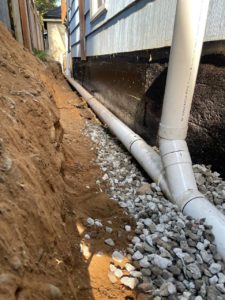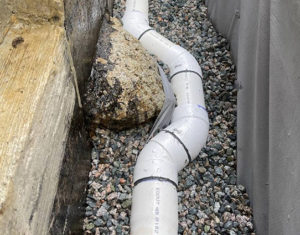In the field of architecture, protecting the foundations of our homes is critical, and the weeping tile drain serves as one of the principal defense mechanisms against water damage. These drains are essentially porous pipes designed for underground drainage, providing a safeguard for the structural integrity of buildings. The term ‘weeping tile’ originates from the initial design, which involved pieces of tiles with slight gaps in between, allowing water to ‘weep’ through these spaces, facilitating efficient drainage away from the foundation.
The Anatomy of Weeping Tile Drain
Today, weeping tiles drain are usually made from plastic, more specifically perforated Polyvinyl Chloride (PVC), and sometimes they come with a sock—a fabric sleeve designed to filter out debris and prevent the tile from getting clogged. Historically, clay weeping tile were also quite common, but plastic ones are predominant due to their durability and effectiveness.
The term “tile” in weeping tile drain harkens back to the time when these systems were constructed using terracotta tiles. Modern weeping tile are typically made of perforated plastic, usually PVC (Polyvinyl Chloride), which is durable and effective at water redirection. These pipes are perforated to allow the ingress of water while remaining buried adjacent to the foundation of a building.
Protecting and Preserving House Foundations Against Water Damage

The primary purpose of installing weeping tile drain around house foundations is to prevent water from getting into the basement. These tiles are placed along the perimeter of the foundation to collect excess water from the soil and divert it away from the structure, safeguarding the integrity of the building’s foundation. The weeping drainage system is crucial in areas prone to heavy rainfall or where the water table is high, as it guards against water infiltration and subsequent damage to the building’s structure and interiors.
Understanding the Importance
Without weeping tile, water can accumulate around the foundation, leading to issues like dampness, mold growth, and structural damage over time. By directing excess water away from the foundation, weeping tile mitigates the risk of moisture-related problems, thus maintaining the longevity and integrity of the structure.
Installing Weeping Tile and Associated Costs
Installing weeping tile drain requires a specific process, starting with excavation around the foundation and laying the weeping tile drain in the correct position, followed by covering them with gravel to filter out soil and debris. The process, though seemingly straightforward, requires precision and knowledge, and thus, it’s usually recommended to be carried out by professionals. Weeping tile cost can vary widely depending on the extent of installation required, material costs, and labor charges, making it essential to get an accurate estimate beforehand.
Weeping Tile without Sump

In many cases, weeping tile drain are connected to a sump, which actively pumps out the collected water. However, it is possible to have a weeping tile drain system without a sump , wherein the tiles redirect the water away from the foundation utilizing gravity, leading it to a storm sewer or another safe drainage area.
Weeping Tile Sump Integration
Integrating a sump with weeping tile drain enhances the efficiency of the drainage system, especially in areas where the water collected by the weeping tile drain cannot be drained adequately by gravity alone. A well-integrated weeping tile drain sump pump system ensures optimal drainage and offers added protection against basement flooding.
Addressing Difficulties: The Importance of Regular Challenges and Maintenance in Ensuring the Optimal Functionality
Weeping tile drain systems, like all systems, are prone to issues such as becoming clogged with soil, roots, or debris, rendering them ineffective. Clogged weeping tile drain can lead to water pooling around the foundation and infiltrating the basement. Regular inspection and maintenance are essential to ensure the longevity and functionality of the weeping tile drainage system.
Weeping Tile Drains With A Sock What Is it?
A weeping tile drain with a sock is a specific type of drainage pipe designed to protect building foundations from water damage. The “sock” in this context is a permeable fabric sleeve that covers the weeping tile drain. This sock acts as a filter, allowing water to enter the pipe while keeping soil, sand, and other debris out, preventing blockages in the weeping tile drain system.
Types of Weeping Tile Drains that Benefit from a Sock:
- Perforated PVC Weeping Tile Drain: Given their widespread use and susceptibility to clogs from small particles, these often benefit the most from being covered with a sock. When installing PVC weeping tile, incorporating a sock is not strictly necessary, but it can be highly beneficial depending on the soil characteristics surrounding the foundation. Weeping tile, including those made of PVC, are perforated to allow water to enter and be redirected away from the foundation. However, these perforations can also allow small soil particles, sand, and silt to enter the tile, which can lead to clogs over time.
- Clay Weeping Tile Drain: While less common nowadays, older clay tiles, especially those with larger gaps or cracks, can benefit from a sock to prevent soil and root intrusion.
- Flexible Drain Pipes: Flexible, corrugated drain pipes often used in drainage solutions also benefit from a sock to prevent clogging from soil and debris infiltration.
Advantages of Using a Sock:
- Reduced Maintenance: The sock minimizes the risk of clogs and reduces the need for frequent maintenance and cleaning of the weeping tile system.
- Extended Lifespan: By preventing clogs and maintaining optimal functionality, a sock can significantly extend the lifespan of the weeping tile system.
- Enhanced Performance: A sock ensures the uninterrupted flow of water, maintaining the efficiency of the drainage system and protecting the foundation from water damage.
Weeping Tile Cost
In the pursuit of safeguarding your home against foundational water damage, investing in a weeping tile installation is a critical and proactive step. Generally, the starting cost for a full-fledged weeping tile installation, complete with a new sump, catch basin, and a surrounding French drain system, hovers around $25,000. However, this investment can vary, particularly influenced by the depth of excavation and the length of material required. Specifically, in the Greater Vancouver area, homeowners should budget for an average cost ranging from $100 to $150 per linear foot, accounting for materials. While this upfront expenditure might seem substantial, the long-term benefits of preventing structural damages, mold growth, and water infiltration make it a worthwhile investment for the structural integrity of the home. It is essential for potential investors to consider local pricing fluctuations and the quality of materials chosen, as these factors significantly impact both the installation costs and the longevity of the weeping tile system. Balancing these variables will aid homeowners in making informed and beneficial decisions, ensuring the optimal protection of their homes against water-related damages and consequent financial hassles.
How To Clean Weeping Tile Drain
Maintaining your home’s foundation through a clean weeping tile system doesn’t have to be complicated. To start, check any parts of the system you can see, like the sump pit and pipes, for any signs of blockages or damage. A helpful tool for this is a fiber-optic drainage camera, which can help you see inside the drainage system and identify any issues. If you find blockages, you can clean out the system using hydro flushing, a method that uses high-pressure water to remove blockages, or a drain auger, a tool designed to break through or pull out obstructions. Regular cleaning of the sump pump is also important to keep everything running smoothly. If you can’t access the system or the blockage is too severe, it might be best to call in a professional. They can use specialized equipment and knowledge to make sure your weeping tile drainage system is working properly, helping protect your home from water damage. Regular check-ups and cleaning can prevent expensive repairs and ensure your foundation stays dry and secure.
Conclusion
Foundation weeping tile drain are integral components in safeguarding the structural integrity of buildings against water damage. From the utilization of perforated PVC weeping tile to the integration with sump pumps, the evolution of weeping tile systems continues to adapt to the varying needs of architectural landscapes.
Whether integrating with a sump pump or installing weeping tile with a sock for added filtration, the importance of proper installation and regular maintenance cannot be overstated. By investing in a robust weeping tile system and ensuring its optimal functionality, homeowners can protect their homes from the detrimental effects of water damage and secure the longevity of their residences.


